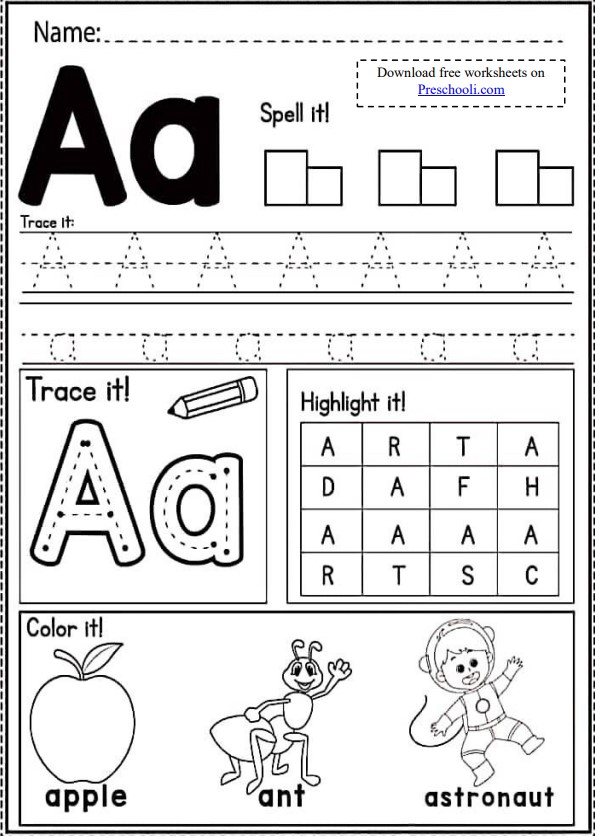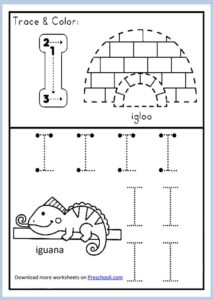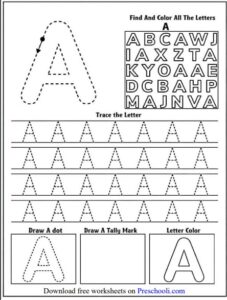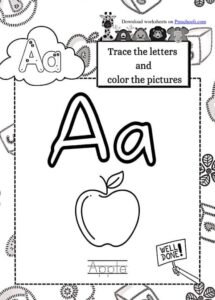Tracing Worksheet for Nursery Schools: A Tool for Early Learning Their ABCs
In the bustling world of early education, where young minds are just starting Tracing Worksheet for Nursery to grasp the basics of language and communication, tools like tracing worksheets can be absolute game changers. Parents, educators, and anyone involved in the nurturing of our little ones know the importance of early literacy. It’s not just about learning the ABCs; it’s about mastering the art of writing them. This post dives into the critical role of tracing worksheets in nursery education, and how they can make the learning process both enjoyable and effective.
Why Focus on Tracing in the Early Years?
The ability to trace letters and shapes isn’t just a prelude to learning how to write; it also hones essential skills like hand-eye coordination, fine motor skills, and spatial awareness. For a preschooler, these foundational motor and cognitive skills are gateway abilities that they’ll use throughout their academic and personal life. Moreover, tracing provides the much-needed introduction to the shapes and directions of letters and numbers, offering a physical reference for their otherwise abstract forms.
Benefits Beyond Penmanship
Tracing is far more than a mere precursor to developing good penmanship; it is an immersive multisensory learning experience that actively engages multiple senses in children, significantly aiding their memory retention. When a child engages in tracing, whether it be a shape, letter, or number, they do not merely observe the motions or listen to instructions. They also experience the sensation through the muscles in their hand, feeling each stroke and curve. This tactile engagement is not just about following a pattern; it’s a deeply interactive learning activity that involves seeing, hearing, and feeling simultaneously. This multisensory approach not only reinforces the learning process but also enhances it, making the information more memorable and impactful for the child. By integrating visual, auditory, and kinesthetic elements, tracing becomes a powerful tool in a child’s educational journey, laying a solid foundation for more complex skills in reading, writing, and beyond.
Designing Effective Tracing Worksheet for Nursery
Creating a tracing worksheet for the nursery isn’t simply about drawing letters and letting kids have at it. There’s an art to building these tools, balancing engagement with the right level of challenge and ensuring that they aid learning.
Clarity and Simplicity are Key
A good tracing worksheet is clear and easy to follow. The lines should be bold enough for a child to see and trace over, yet not so thick that they obscure the form. Additionally, a simple, uncluttered layout allows children to focus on the tracing task without any unnecessary distractions.
Gradual Increase in Complexity
Worksheets should be designed with a progression in mind. Begin with simple shapes and straight lines, gradually increasing the complexity with curves and diagonal lines. The same approach applies to letters, ensuring that young learners first master the less intricate forms before moving on to more challenging ones.
Engaging Visuals
The visual appeal of a worksheet can significantly impact a child’s enthusiasm for the task. Use bright colors, fun characters, and relatable themes to make the worksheet more exciting. For instance, incorporate pictures of animals or objects that start with the traced letter, creating an association between the visual and auditory learning of the letter sound.
The Role of Technology in Tracing Worksheet for Nursery
With the advent of educational technology, tracing worksheets have evolved beyond pen and paper. Educational apps and interactive digital platforms can enrich the tracing experience, adding a layer of interactivity that can be highly engaging for young children.
Interactive Tracing
Interactive tracing apps allow kids to trace letters using a touchscreen device, offering real-time feedback and correction. Such apps can provide encouragement and make the learning process feel more like a game, increasing motivation and enjoyment.
Accessibility and Variety
Digital platforms also offer a wide array of tracing themes and styles, adapting to the child’s progress and preferences. Whether a child needs practice with their ABCs, numbers, or shapes, there’s a digital tracing tool available for every need, making it a versatile addition to any early learning curriculum.
Tracking and Reporting
Digital tracing tools can provide parents and educators with valuable insights into a child’s learning. They can track progress, identify areas that need improvement, and adjust the learning path accordingly. This feedback loop is a powerful feature that traditional tracing worksheets can’t offer.
Using Tracing Worksheets to Enhance the Learning Experience
The real magic of tracing worksheets lies in their ability to foster a love for learning. When integrated into a comprehensive learning environment, they can significantly enhance early literacy programs.
Integration with Storytelling
Incorporating tracing activities alongside storytelling can significantly enhance the learning experience and imbue it with meaning. To achieve this, select stories that prominently feature the letter currently being focused on in the lesson. Encourage children to actively trace the letter with their fingers while the story is being narrated.
This interactive approach not only engages them but also helps establish a direct connection between the letter, its corresponding sound, and the narrative context of the story. This method of teaching not only makes the learning process more enjoyable but also greatly supports memory retention by providing a clear, contextual backdrop for the abstract concept of letters and sounds.
Multisensory Learning
Incorporate a variety of materials and textures to enrich the tracing experience. Introduce sandpaper letters to provide a rough sensory feel, which can be particularly engaging for young learners as they trace each letter with their fingers. Alternatively, use a tray filled with salt or paint to create a smoother sensory experience.
This contrast in textures can help children to better differentiate the shapes of letters and numbers. Engaging in such multi sensory activities allows children to experience learning through different sensory inputs, making the process more memorable and robust. This approach caters to various learning styles and can significantly enhance the overall learning experience for children.
Reinforcement and Repetition
Repetition plays a vital role in the learning process for young students. Incorporating tracing worksheets consistently into the curriculum is highly beneficial, as it reinforces the shapes and movements required for letter formation through regular practice. This method of repetition not only aids in developing muscle memory but also establishes a robust foundation for writing skills.
By engaging in this repetitive practice, young learners become more familiar and comfortable with the act of writing, which in turn, enhances their ability to retain and recall information. Ultimately, repetition through tracing worksheets is a powerful tool in setting a strong educational groundwork for children.
How to Integrate Tracing Worksheets at Home and in the Classroom
Both the home environment and the classroom provide perfect settings for the utilization of tracing worksheets, serving as foundational tools for early learning.
At home, parents can use these worksheets to create a bonding experience with their children, tailoring the pace to the child’s individual learning speed. In the classroom, teachers can integrate them into their lesson plans to reinforce handwriting and shape recognition skills among students. While the strategies for integration may differ slightly between home and school settings the former being more flexible and personalized, and the latter more structured the overarching goal remains the same: to facilitate effective skill development within a nurturing and supportive context.
Classroom Integration
In a nursery or preschool setting, tracing activities can be integrated into a structured academic schedule. Allocate specific times for tracing sessions, perhaps as a warm-up or transition activity. Encourage peer to peer learning and provide one-on-one support where necessary.
Home Use
For parents looking for effective educational tools, tracing worksheets offer a versatile solution that can be easily incorporated into the daily routine of children. These worksheets can be utilized during various times of the day, such as morning routines to kickstart the day with a learning activity, or bedtime routines to wind down with something calming yet educational.
Additionally, they are perfect for quiet, independent learning time, allowing children to practice their skills while parents attend to other tasks. One of the significant advantages of tracing worksheets is that they require minimal materials often just the worksheets and something to write with making them an exceedingly convenient and low maintenance educational tool for any household. This ease of use, combined with the developmental benefits they offer, makes tracing worksheets an invaluable resource for fostering early learning skills.
Collaborative Approach
Parents and educators can adopt a collaborative approach when it comes to utilizing tracing worksheets, a key tool in early childhood education. By sharing insights about each child’s progress and experiences, they can reinforce what is being learned in the classroom at home. Additionally, providing detailed feedback to each other about the child’s engagement and challenges with the worksheets can enhance the learning process. This symbiotic relationship between parents and educators ensures that the child benefits from a consistent and supportive learning environment, both at school and at home, paving the way for a more holistic educational experience.
Conclusion
Tracing worksheets may seem like a simple tool, but their impact on nursery education is far-reaching. They contribute to the development of essential motor skills, reinforce early literacy, and set the stage for more advanced academic pursuits. In designing and implementing these worksheets, the focus should always be on the holistic development and joyful learning of the child. With the right approach, tracing can be more than a task it can be an adventure in each child’s academic and personal growth.
Join our Facebook Group



